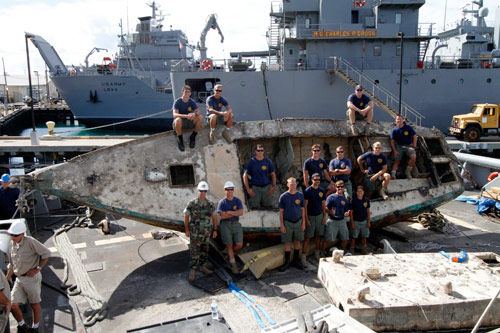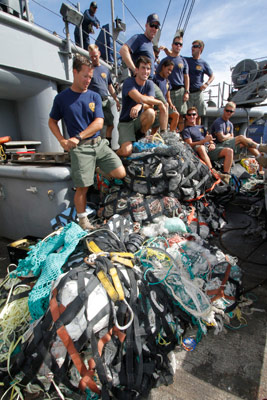Ship salvaged after 4 years

Members of the Mobile Diving and Salvage Unit posed yesterday with the wrecked sailboat they pulled from waters off Kure Atoll.

Salvage divers display marine debris they collected from the waters of Papahanaumokuakea Marine National Monument.


For four years the steel hull of the Grendel — a 33-foot-long sailboat — rested under 10 feet of water at Kure Atoll.
But thanks to the efforts of the U.S. Navy and the National Oceanic and Atmospheric Administration, the ship now sits dry in an Oahu steel yard waiting to be recycled.
"It was a long and arduous process," said NOAA spokesman Dan Dennison. "But we are really thrilled that it got salvaged."
The Grendel arrived at Pearl Harbor on Thursday aboard the USNS Salvor. The naval vessel was part of a mission run by NOAA with assistance from the Navy Mobile Diving and Salvage Unit to recover the wreckage and collect more than 8,000 pounds of fishnets, buoys and marine debris from across the Northwestern Hawaiian Islands.
"It’s a great opportunity for our guys to be part of something like this," said Lt. Jon Corkey, the officer in charge of the dive mission. "We use it as a training value and to help the state of Hawaii."
NOAA’s Office of Marine Sanctuaries led the mission with the help of a 17-person crew from the Pearl Harbor-based diving unit. Both NOAA and Navy personnel flew to Kure Atoll — a tiny coral island about 1,300 miles from Honolulu — on July 10 to meet up with the USNS Salvor, which was returning to Hawaii from a six-month deployment in the western Pacific.
Don't miss out on what's happening!
Stay in touch with breaking news, as it happens, conveniently in your email inbox. It's FREE!
Salvage operations on the sunken sailboat lasted five days and required months of planning and coordination by government agencies.
To refloat the vessel, diving crews sucked tons of sand from the Grendel’s cabin and patched holes in its hull. Crews then attached large pontoons to the ship’s top and sides to bring the vessel to the surface and drain its cabin. The Grendel was towed to deeper water and lifted by crane onto the Salvor for transport back to Hawaii.
"This was an opportunity for us to gain real-world salvage experience," said Cmdr. Thomas Murphy, commanding officer of the Pearl Harbor diving unit. "We provided our services to help (NOAA) accomplish their mission. Everybody wins."
The Grendel was last seen leaving Fiji with its solo captain in October 2006, and is believed to have run aground on a reef in late 2006 or early 2007. The private vessel was discovered off Kure Atoll in June 2007, but no trace of the captain has ever been found.
According to NOAA, the sunken vessel posed a threat to protected marine life. NOAA said it was concerned that strong storm currents would thrust the steel hull into nearby reef or snag fishing debris to create an entanglement hazard for endangered monk seals, turtles and whales.
The naval team collected tons of marine debris from waters around the Northwestern Hawaiian Islands and helped with ongoing NOAA removal of invasive plants from Kure.
"I didn’t realize how much that island is getting affected by the garbage," said Navy diver Scott Edwards, who served as diving supervisor on the mission. "It’s like a big cyclone of garbage."
The team also learned about conservation efforts in the Papahanaumokuakea Marine Monument — a 140,000-square-mile preserve established in 2006.
"An important part of this kind of mission is the environmental consideration," Murphy said. "It gives the divers better appreciation of their mission and what they were doing for the island."
After recovering the vessel, the Salvor made a brief stop to pick up scrap metal from a closed U.S. military base on Midway Atoll. Hoping to keep tons of steel and fishing debris out of the Pacific Ocean, NOAA is working with local firms to ensure that all of the material is being disposed of properly. The steel hull and scrap metal from the sailboat has been transported to Schnitzer Steel Hawaii Corp., and all marine debris has been taken to Covanta Energy’s plant to be burned to generate electricity.
"This was a great example of them being able to recycle 100 percent of what they took from the reef," Dennison said. "Just to keep the place really pristine is a continuous process."




